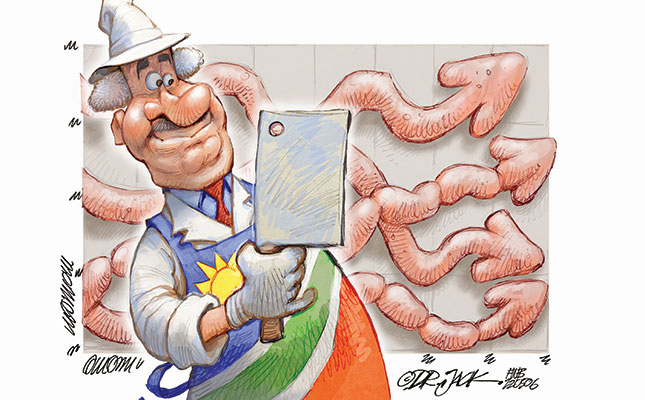
In June of 2013, the year which saw the start of Namibia’s prolonged drought, the country’s agricultural debt stood at N$4,5 billion (about R4,5 billion). Exactly seven years later, this figure had soared to N$7,8 billion, an increase of 74%.
At the onset of the COVID-19 pandemic in 2020, the government implemented a number of interventions, including a reduction in the interest rate. This, in combination with good producer prices that year, left the interest payment as a percentage of gross income at 7,6%, which would have been ideal in a stable production system.
In the same year, Namibian farmers began to rebuild their herds after the drought, which had led to the deaths of almost half their total livestock. As a result, producers had fewer animals to market, and this, coupled with cyclical and long-term debt, negatively affected their ability to repay loans.
The arrival of the COVID-19 pandemic saw the government declare a state of emergency and impose numerous restrictions, but agriculture was largely spared these, being classified an essential service due to the role it played in the economy.
Nonetheless, this did not prevent the pandemic from having a negative impact on the sector.
The international travel ban, for example, affected the transportation of pelts to auctions by air, which led to the cancellation of the country’s April 2020 auction.
The slowdown in economic activities put pressure on consumers’ income, changing their purchasing behaviour and reducing demand for protein, and hence red meat. In 2020, Namibia finally received good rainfall in most of its cattle-producing areas, which encouraged farmers to start restocking.
Decrease in production
Namibia’s Swakara sheep industry incurred major production losses between 2017 and 2019, and the pandemic exacerbated the industry’s woes in 2020. By the end of that year, the sector had sold 8 354 pelts at a production value of about R2,8 million, about 87,9% less than in 2019.
Cattle and sheep production values for 2020 were 33% and 42,8% lower year-on-year (y/y) respectively, while that of goats dropped by 13,9%.
Raw milk production fell to 17,2 million litres in 2020, a 21,1% decrease from the 21,8 million litres of 2019. This reduction stemmed mainly from three factors: the 2019 drought, which resulted in low water levels in dams until March 2020; a significant decline in fodder production at Hardap Dam, where close to 80% of the country’s milk is produced; and farmers ceasing production.
In contrast, production of white maize and wheat increased significantly over this period: from 28 887t and 4 466t respectively in 2019/20 to 66 641t and 11 498t respectively in 2020/21. This growth in tonnage boosted the production value of white maize by 123,3% and that of wheat by 174,3%, which explains the impressive increase of 142,7% in agronomy production value.
In 2020, Namibia’s grape sector exported an estimated 8,7 million 4,5kg-equivalent cartons, up from 6,1 million in 2019. This amounted to a production value of about R1,1 billion, a rise of 39,6%.
Auctions and exports
The numbers of cattle, sheep and goats marketed in 2020 were, respectively, 49%, 52,6% and 41,1% down on the figures of 2019. This led to a low throughput to sheep-export abattoirs, and the resultant closure of one of the last two export abattoirs in Namibia.
The total number of cattle auctioned in 2020 was 238 976, down by 26,4% on the three-year (2017 to 2019) average of 324 577 cattle.
Live cattle exports also saw a decline. A total of 158 679 head of cattle were exported in 2020, a decline of about 48,2% from the three-year average of 306 340. Of the cattle exported in 2020, more than 90% were weaners.
A total of 162 852 weaners were auctioned in 2020, compared with an average of 230 117 between 2017 and 2019, a drop of 29,2%. A total of 57 137 weaned heifers were auctioned in 2020, compared with an average of 81 808 between 2017 and 2019. Exports of heifers declined too: a total of 12 420 were exported in 2020, a drop of 66,3% from the three-year average of 36 838.
The number of animals secured by sheep-export abattoirs in 2020 was 25 341, down 86,8% from the 194 510 between 2017 and 2019.
Exports of live sheep also failed to perform, declining to 227 583 in 2020, a 47,7% drop from the three-year average of 435 441 animals. Abattoirs (B and C classes) procured 115 548 sheep in 2020, compared with 148 681 between 2017 and 2019.
Local abattoirs recorded a throughput of 6 999 goats in 2020, which was 39,5% higher than the average of 5 018 between 2017 and 2019. Live goat exports totalled 81 301 in 2020, 43,8% down from the three-year average of 144 657. The halt of social gatherings due to COVID-19-related restrictions negatively affected the export of live goats from Namibia to South Africa.
In 2021, Namibian livestock producers continued to reinvest in the sector to rebuild their stocks and grow the national herd. For this reason, the number of cattle, sheep and pigs marketed during the first half (H1) of 2021 fell by 25,2%, 4,7% and 1,3% respectively from the figures of H1 2020. The number of goats marketed increased by 63,8%, however.
Approximately 30% fewer cattle were auctioned in H1 2021 than in H1 2020: 91 302 compared with 130 108. A total of 57 683 live cattle were exported in H1 2021, of which more than 90% were weaners. This was a decline of 23,4% from the 75 301 cattle exported in the same period in 2020. In all, 59 635 weaners were auctioned in H1 2021, a drop of 31,7% y/y.
The number of heifers exported expressed as a percentage of those sold on auction was estimated to be 15,6% in H1 2021, compared with 19,5% in H1 2020, indicating that the number of heifers absorbed by the domestic market increased.
Export abattoirs received 14 436 head of cattle in H1 2021, which means that slaughter at these abattoirs contracted by 31% on average. The only remaining sheep-export abattoir secured 8 193 animals in H1 2021. Between H1 2020 and H1 2021, live-sheep exports grew by 19,9%, from 142 067 to 170 375 animals.
Producer prices and inflation
The depreciation of the Namibian dollar against foreign currencies contributed to an increase in prices of imported products in 2020. Livestock producer prices performed well that year compared with 2019 due to high demand for livestock.
With good weaner prices, the total weighted cattle price rose by 14% from the fourth quarter (Q4) of 2017 to Q4 2020. The price of weaners increased by 16,3%.
Sheep producer prices increased by 21% over the same period.
Agricultural inflation in H1 2021 was 7% higher than in H1 2020. This emanated from price hikes for fuel (up 7,7%), maintenance and fixed improvements (up 12,9%), capital expenditure (up 17,4%) and healthcare costs (up 6,6%).
The price of sheep was 26% higher in H1 2021 than in H1 2020, and the price of cattle increased by more than 17,6% on the back of a 21,8% and 11,4% rise in the prices of weaners and oxen respectively. The production and sale of weaners remained more profitable than growing out weaners to oxen because, on average, the weaner price as a percentage of the slaughter price stood at 76% in H1 2021.
Improved weaner prices between 2020 and 2021 left the average weaner price as a percentage of the slaughter price above the long-term average of 64%, thus making weaner production profitable. However, slaughter cattle prices recovered in 2021, leading to an improvement in the income for cow-ox producers.
The domestic market was under considerable pressure from the global market, particularly as food inflation rose by more than 26,1% between H1 2020 and H1 2021. This was due to significant increases in the prices of oils, grains and meat.
On average, oil prices grew by 74,8% due to a rise in value of palm, soya bean, and
canola oils; grain prices increased by over 28,8% as a result of significant hikes
in the prices of maize and wheat; and meat prices increased by an average 4,3%, due
to tight global supply and strong import demand from East Asian countries, particularly China.
The views expressed in our weekly opinion piece do not necessarily reflect those of Farmer’s Weekly.
Visit the Namibia Agricultural Union’s website at nau.com.na.










